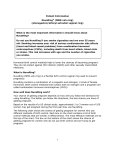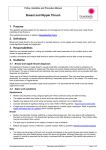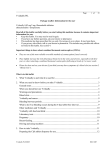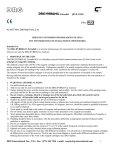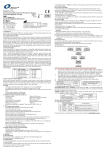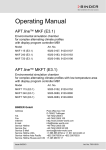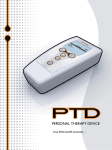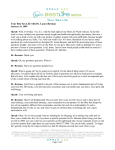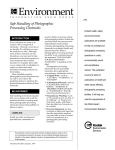Download CERAZETTE®
Transcript
CERAZETTE® Tablets for oral use Consumer Medicine Information What is in this leaflet • • • • Keep this leaflet. You may need to read it again. This leaflet will provide information about the benefits and risks of Cerazette®. It will also advise you about how to take Cerazette® properly and when to tell your doctor about healthrelated conditions. If you have any further questions, ask your doctor or your pharmacist. This medicine has been prescribed for you. Do not pass it on to others. It may harm them, even if their symptoms are the same as yours. If any of the side effects gets serious, or if you notice any side effects not listed in this leaflet, please tell your doctor or your pharmacist. What is CERAZETTE and what is it used for? preventing the sperm cells from entering the womb but, unlike combined pills, they do not always prevent an egg cell from ripening. Cerazette® is distinct from other mini-pills because, like combined pills, in most cases it does prevent the egg cells from ripening. As a result, Cerazette® provides high contraceptive efficacy. In contrast to the combined pill, Cerazette® can be used by women who do not tolerate oestrogens and by women who are breast feeding. A disadvantage is that vaginal bleeding may occur at irregular intervals during the use of Cerazette®. You also may not have any bleeding at all. Why is Cerazette® used? To prevent pregnancy. When Cerazette® is taken correctly (without missing tablets), the chance of becoming pregnant is very low. Before you start to take Cerazette® Cerazette®, like all hormonal contraceptives, does not protect against HIV infection (AIDS) or any other sexually transmitted disease. ® ® How does Cerazette work? Cerazette® contains a small amount of one type of female sex hormone, the progestagen desogestrel. For this reason Cerazette® is called a progestagen-only-pill (POP), or a mini-pill. Contrary to combined pills, mini-pills do not contain an oestrogen hormone next to the progestagen. Most mini-pills work primarily by When should you not take Cerazette®? Do not use Cerazette® if you have any of the conditions listed below. If any of these apply to you, tell your doctor before starting to use Cerazette®. Your doctor may advise you to use a nonhormonal method of birth control. • If you have a thrombosis. Thrombosis is the formation of a blood clot in a blood vessel [e.g. of the legs (deep venous • • • • • thrombosis) or the lungs (pulmonary embolism)]. If you have jaundice (yellowing of the skin) or severe liver disease. If you have a cancer that grows under the influence of sex steroid hormones. If you have any unexplained vaginal bleeding. If you are pregnant or think you might be pregnant. If you are allergic to any of the ingredients of Cerazette®. If any of these conditions appear for the first time while using Cerazette® you should consult your doctor promptly. When do you have to take special care with Cerazette®? If Cerazette® is used in the presence of any of the conditions listed below, you may need to be kept under close observation. Your doctor can explain to you what to do. Therefore, if any of these apply to you, tell your doctor before starting to use Cerazette®: • • • • • • • • You have or have had breast cancer; You have liver cancer; You have ever had a thrombosis; You have diabetes; You suffer from epilepsy; You suffer from tuberculosis; You have high blood pressure; You have or have had chloasma (yellowishbrown pigmentation patches on the skin, particularly of the face); if so avoid too much exposure to the sun or ultraviolet radiation. Potentially serious conditions Decreased Bone Mass Oestrogens are important to maintain the strength of your bones. During the use of Cerazette®, the concentration in your blood of the natural oestrogen estradiol is comparable to the concentration seen in the first half of your natural cycle but is decreased in comparison with the second half of the natural cycle. It is not known whether this has an effect on the strength of your bones. Breast Cancer Every woman is at risk of breast cancer whether or not she takes oral contraceptives (‘the Pill’). Breast cancer has been found slightly more often in women who take the Pill than in women of the same age who do not take the Pill. When women stop taking the Pill, the risk gradually decreases, so that 10 years after stopping the risk is the same as for women who have never taken the Pill. Breast cancer is rare under 40 years of age but the risk increases as the woman gets older. Therefore, the extra number of breast cancers diagnosed is higher among women who use the Pill at a higher age. How long a woman takes the Pill is less important. In every 10,000 women who take the Pill for up to 5 years but stop taking it by the age of 20, there would be less than 1 extra case of breast cancer found up to 10 years after stopping, in addition to the 4 cases normally diagnosed in this age group. Likewise, in 10,000 women who take the Pill for up to 5 years but stop taking it by the age of 30, there would be 5 extra cases in addition to the 44 cases normally diagnosed. In 10,000 women who take the Pill for up to 5 years but stop taking it by the age of 40, there would be 20 extra cases in addition to the 160 cases normally diagnosed. Breast cancers found in women who take the Pill, seem less likely to have spread than breast cancers found in women who do not take the Pill. It is not known whether the difference in breast cancer risk is caused by the Pill. It may be that the women were examined more often, so that the breast cancer is noticed earlier. Thrombosis Thrombosis is the formation of a blood clot, which may block a blood vessel. A thrombosis sometimes occurs in the deep veins of the legs (deep venous thrombosis). If this clot breaks away from the veins where it is formed, it may reach and block the arteries of the lungs, causing a so-called “pulmonary embolism”. As a result, fatal situations may occur. Deep venous thrombosis is a rare occurrence. It can develop whether or not you are taking the Pill. It can also happen if you become pregnant. The risk is higher in Pill-users than in non-users, but it is not as high as the risk during pregnancy. The risk with progestagen-only pills like Cerazette® is believed to be lower than in users of Pills that also contain oestrogens (combined Pills). If you notice possible signs of a thrombosis, you should see your doctor immediately. (See also section ‘When should you contact your doctor’?). Using Other Medicines Some medicines may stop Cerazette® from working properly. These include medicines used for the treatment of epilepsy (e.g. primidone, phenytoin, barbiturates), or tuberculosis (e.g. rifampicin, rifabutin), and HIV infections (e.g. ritonavir), or other infectious diseases (e.g. griseofulvin), medical charcoal used for stomach upset, and the herbal remedy St John’s wort (primarily used for the treatment of depressive moods). Always tell the doctor, who prescribes Cerazette®, which medicines you are already using. Your doctor can tell you if you need to take additional contraceptive precautions and if so, for how long. Vaginal Bleeding Vaginal bleeding may occur at irregular intervals during the use of Cerazette®. This may be just slight staining which may not even require a pad, or heavier bleeding, which looks rather like a scanty period and requires sanitary protection. You may also not have any bleeding at all. The irregular bleedings are not a sign that the contraceptive protection of Cerazette® is decreased. In general, you need not take any action; just continue to take Cerazette®. If, however, bleeding is heavy or prolonged consult your doctor. Ovarian Cysts During the use of all low-dose hormonal contraceptives, small fluid-filled sacs may develop in the ovaries. These are called ovarian cysts. They usually disappear on their own. Sometimes they cause mild abdominal pain. Only rarely, they may lead to more serious problems. Pregnancy Cerazette® must not be used by women who are pregnant, or who think they may be pregnant. Breastfeeding Cerazette® may be used while you are breastfeeding. Cerazette® does not influence the production or the quality of breast milk. However, a small amount of the active substance of Cerazette® passes over into the milk. The health of breast-fed children whose mothers were using Cerazette® has been studied up to 2.5 years of age. No effects on the growth and development of the children were observed. • • • • If you are breastfeeding and want to use Cerazette®, please contact your doctor. Driving and using machines There are no indications of any effect of the use of Cerazette® on alertness and concentration. Important information about some of the ingredients of Cerazette® If you have been told by your doctor that you have intolerance to some sugars, contact your doctor before taking Cerazette®. When should you contact your doctor? Regular check-ups When you are using Cerazette®, your doctor will tell you to return for regular checkups. In general, the frequency and nature of these check-ups will depend on your personal situation. Contact your doctor as soon as possible if: • you notice possible signs of • • a thrombosis (e.g. severe pain or swelling in either of your legs, unexplained pains in the chest, breathlessness, an unusual cough, especially if you cough up blood); you have a sudden, severe stomach ache or look jaundiced (indicating possible liver problems); you feel a lump in your breast; you have a sudden or severe pain in the lower part of your belly or the stomach area (possibly indicating an ectopic pregnancy, this is a pregnancy outside the womb); you are to be immobilised (for example being confined to bed) or are to have surgery; consult your doctor at least four weeks in advance; you have unusual, heavy vaginal bleeding; you suspect that you are pregnant. day until the pack is empty, always following the direction indicated by the arrows. By looking at the back of your pack you can easily check if you have already taken your tablet on a particular day. Take your tablet each day at about the same time. Swallow the tablet whole, with water. You may have some bleeding during the use of Cerazette®, but you must continue to take your tablets as normal. When a pack is empty, you must start with a new pack of Cerazette® on the next day – thus without interruption and without waiting for a bleed. You can stop taking Cerazette® whenever you want. From the day you stop you are no longer protected against pregnancy. Starting your first pack of Cerazette® • If you are not taking the pill at present. Wait for your period to begin. On the first day of your period take the first Cerazette® tablet. You need not take extra contraceptive precautions. You may also start on days 2-5 of your cycle, but in that case make sure you also use an additional contraceptive method (barrier method) for the first 7 days of tablet-taking in the first cycle. • When you change from a combined pill, vaginal ring, or transdermal patch. You can start taking Cerazette® on the day after you take the last tablet from your present Pill pack, or on the day of removal of your vaginal ring or patch (this means no tablet-, ring-, or patch-free break). If your present Pill pack also contains inactive tablets you can start Cerazette® on How do you take CERAZETTE®? When and how to take the tablets? The Cerazette® pack contains 28 tablets. Arrows are printed on the front side of the pack, between the tablets. If you turn over your pack, and look at the back side, you will see the days of the week printed on the foil. Each day corresponds to one tablet. Every time you start a new pack of Cerazette®, take a tablet from the top row. Don’t start with just any tablet. For example if you start on a Wednesday, you must take the tablet from the top row marked (at the back) with WED. Continue to take one tablet a the day after taking the last active tablet (if you are not sure which this is, ask your doctor or pharmacist). If you follow these instructions, it is not necessary to use an additional contraceptive method. You can also start at the latest the day following the tablet-, ring-, patch-free break, or placebo tablet interval, of your present contraceptive. If you follow these instructions, make sure you use during the first cycle an additional contraceptive method (barrier method) for the first 7 days of tablet-taking. • • • When you change from another progestagen-only pill (mini-pill). You may stop taking it any day and start taking Cerazette® right away. You need not take extra contraceptive precautions. When you change from an injectable or implant or a progestagen-releasing intrauterine device (IUD). Start using Cerazette® when your next injection is due or on the day that your implant or your IUD is removed. You need not take extra contraceptive precautions. If you have just had a baby. You can start Cerazette® between 21 and 28 days after the birth of your baby. If you start later, make sure you use during the first cycle an additional contraceptive method (barrier method) for the first 7 days of tablet-taking. However, if intercourse has already occurred, pregnancy should be excluded before starting Cerazette® use. Additional • information for breast feeding women can be found in the paragraph “Breastfeeding” in the section “When do you have to take special care with Cerazette®”. Your doctor can also advise you. you forget to take one or more tablets”. If you have severe diarrhoea, please contact your doctor. After miscarriage or an abortion. Your doctor will advise you. There have been no reports of serious harmful effects from taking too many Cerazette® tablets at one time. Symptoms that may occur are nausea, vomiting and, in women or girls, slight vaginal bleeding. For more information ask your doctor for advice. If you forget to take one or more tablets If you are less than 12 hours late in taking a tablet, the reliability of Cerazette® is maintained. Take the missed tablet as soon as you remember and take the next tablet at the usual time. If you are more than 12 hours late in taking any tablet, the reliability of Cerazette® may be reduced. The more consecutive tablets you have missed the higher the risk that the contraceptive efficacy is decreased. Take the last missed tablet as soon as you remember and take the next tablet at the usual time. Use a condom too for the next 7 days of tablet-taking. If you missed one or more tablets in the first week of tablet-intake and had intercourse in the week before missing the tablets, there is a possibility of becoming pregnant. Ask your doctor for advice. If you suffer from gastrointestinal disturbances (e.g. vomiting, severe diarrhoea) If you vomit within 3-4 hours after taking your Cerazette® tablet or have severe diarrhoea, the active ingredient may not have been completely absorbed. Follow the advice for missed tablets in the section “If If too many Cerazette® tablets are taken (overdose) If you want to stop taking Cerazette® You can stop taking Cerazette® at any time you want. If you do not want to become pregnant, ask your doctor about other methods of birth control. If you stop using Cerazette® because you want to get pregnant, it is generally recommended that you wait until you have had a natural period before trying to conceive. This helps you to work out when the baby will be due. Possible Side Effects Like all medicines, Cerazette® can cause side effects, although not everybody gets them. Tell your doctor if you notice any unwanted effect, especially if severe or persistent, or if there is a change in your health that you think might be caused by Cerazette®. Serious side effects Serious undesirable effects associated with the use of contraceptive Pills are described in the section “When do you have to take special care with Cerazette®”. Please read this section for additional information and consult your doctor at once where appropriate. Other possible side effects Common (occurring in more than one per 100 users) are: • Mood altered, decreased sexual drive (libido) • Headache • Nausea • Acne • Breast pain, irregular or no menstruation • Increased body weight Uncommon (occurring in more than one per 1000 users but not more than one per 100 users) are: • Infection of the vagina • Difficulties in wearing contact lenses • Vomiting • Hair loss • Painful menstruation, ovarian cyst • Tiredness Rare (occurring in less than one per 1000 users) are: • Rash, hives, painful bluered skin lumps (erythema nodosum) (these are skin conditions) If any of the side effects gets serious, or if you notice any side effects not listed in this leaflet, please tell your doctor. How to store CERAZETTE® Store between 2°C to 30°C, protected from light and moisture. Do not use after the expiry date stated on the package. Keep your tablets out of the reach and sight of children! Further information What Cerazette® contains The active substance is: desogestrel (75 micrograms). The other ingredients are: silica; colloidal anhydrous; allrac-a-tocopherol; lactose monohydrate; maize starch; povidone; stearic acid; hypromellose; macrogol 400; talc and titanium dioxide (E 171). What Cerazette® looks like and the content of the package One blister pack of Cerazette contains 28 white round tablets. The tablets are coded KV above 2 on one side and ORGANON* on the reverse side. Each carton contains 1 or 3 blister packs, each separately packed in a sachet. Not all pack sizes may be available. Sponsor Merck Sharp & Dohme (NZ) Ltd P O Box 99 851 Newmarket Auckland 1149 Telephone: 0800 500 673 This leaflet was updated in February 2012 (LEI). OS UPL RA 0390 OS P3 (ref 5.0)





